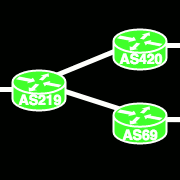|
didnt vote as the scale caps at 5
|
|
|
|

|
| # ? Apr 23, 2024 13:13 |
|
i'll have to think about that, because i dont really have much usable for a roof
|
|
|
|
is amateur radio astronomy a thing or are the wavelengths too long for anyone w/o $10k lying around to bother with
|
|
|
coffeetable posted:amateur radio astronomy Don't stop almost there
|
|
|
|
|
CW, or NO THEY'RE NOT AUTISTS Continuous Wave (as opposed to the 'damped wave' that faded out from the old spark gap transmitters) is the oldest legal radio transmission mode. Classified by the FCC as Emissions class A1A, it is a digital mode and is the simplest thing you can do. Turn a transmitter on and off, really fast. It spits out a single frequency signal, with the effective bandwidth being roughly proportional to the speed of the code sent. Slower speeds can be picked out easier among a bunch of nearby signals. The only encoding used is ye olde Morse Code. I'll admit that I am no longer FLUENT fluent in CW (We call it CW, not Morse, even when we're doing things like generating a tone on an FM signal instead of true A1A emissions) but I possess enough to pick out some stuff here and there at reasonable speeds, and can send at about 10 words per minute. I passed the 5 words per minute test back in like '94, and that applied as credit towards my Extra license (its true that you no longer need the code, but I got my Extra before they dropped that requirement, because i wanted to cluck about it) In order to transmit CW, you need a way to generate it. The simplest is a straight key - a simple on-off switch. Here's a guy using a straight key to make a short contact. https://www.youtube.com/watch?v=v0QddynWDt0 The other type of mechanical key is the semi-automatic, or 'bug'. Synonymous with Vibroplex, the largest manufacturer, these use a left-right action instead of up-down, and have a short sprung pendulum assembly to allow the automatic sending of repeated 'dits' (the short ones). Dahs (long) are still sent via a manual action. Here's a guy cranking it out at pretty good speed (oh yeah these things have a minimum speed they can be set to, so if you can't crank about 20-25 wpm, dont even try it): https://www.youtube.com/watch?v=Lo9uFGJS0vY After that, some fellas set up the electronic equivalent of the Vibroplex's dit-dit-dit circuit, and added one for the dahs as well. Then they just took a Vibroplex type left-right key, and instead of the spring circuit just made it contact one of two different terminals. And the paddle was born. https://www.youtube.com/watch?v=VmG8FxnIMF4 Some cool dude then figured out that if you had two paddles, one for each side, you could have a device that could close both contacts at once - and they used this to trigger an alternating pattern. So if you close the dah side first, then dit, it starts cranking out -.-.-.-. till you let go. Close the dit side first, and you get .-.-.-; furthermore, if you're sending a string of dits or dahs and you want to insert one of the other ones, just tap the other side and it'll add one in. now you combine this with the technique of the single paddle, and you get the iambic paddle! (note: This video is cool - these guys are using the 6 meter band, and bouncing their signals off of patches of aurora - it's really ionized, so sometimes it will reflect signals in the lower VHF range. The raspy tone on the remote station is due to the weird way the propagation works. this is a situation where CW shines - there is NO way these guys could use voice) https://www.youtube.com/watch?v=iJ2udTxn3SU And iambic paddles are pretty much the state of the art for hand-sent CW for poo poo, probably 50+ years now. Some dudes run high speed CW using computers, which can both send and recieve pretty flawlessly up to like 120 WPM, but there's a lot of hate for it. Sometimes the computers are necessary when doing extremely weak-signal work like moonbounce and meteor scatter, but that is very niche and accepted. and poo poo,now i'm motivated to go download some practice software and get my CW groove back. ughhhhhhhhh Jonny 290 fucked around with this message at 03:05 on Feb 22, 2014 |
|
|
|
Jonny 290 posted:From the center of the antenna, you're going to need to run a coax cable feedline into the house to the radio. Length is not SUPER important at CB frequencies, but you still want to keep the run as short as possible. Lower-loss coax is WAY pricey and like a half inch around, so you want to try to keep the run to less than maybe 50 feet or so. rg6 should be good enough for a few hundred feet i think
|
|
|
|
PuTTY riot posted:i read the whole thing and ur the best jonny agreedo makes me want to watch frequency again because i like technology and also people who make cheesy films about said technology 1.21 gigahertz!?!?
|
|
|
|
PuTTY riot posted:i read the whole thing and ur the best jonny
|
|
|
|
Jonny 290 posted:I WANNA LISTEN TO THE COPS sf people: http://www.scansf.com/
|
|
|
|
Jonny 290 posted:"You mentioned CB, how's that doing?" iirc there was (is?) a trucker in AI who used to blast anime theme songs through his CB at truck stops and told stories of the insane screaming rednecks hurling racial slurs at him to shut it off almost made me want a CB to drown out political right wingers with the happy days theme song good thread btw
|
|
|
|
basically what i got out of this is that i should buy a cb radio and put an antenna on my car
|
|
|
|
15 years since i got my general  i still have my yaesu ft-50r. i ought to keep it charged for when the power grid gets hacked.
|
|
|
|
swamp izzo posted:My favorite things about the radio are Macklemore, Jayson DeRulo, Ke$ha, and Pitbull. huh, guess my chris brown shoes were wasted on you smh....
|
|
|
|
all i remember from morse is kangaroo, e, s and o.
|
|
|
|
thread owns an engineering student in holland made a web SDR gateway. SDR is hella cool b/c it basically allows you to listen to the whole spectrum at once (as much as your gear allows) then do the actual tuning and signal processing in software. this allows you to tune to any number of signals, simultaneously! so anyway this guy went and did that and made a web interface for it, so now you can go ahead and listen to a p big spectrum without needing any gear yourself.   http://websdr.ewi.utwente.nl:8901/ Oh and BTW they call the CB band 27MC here, MC being MegaCycles, the ye olde way of saying MegaHertz. you can imagine non-radio people getting 27mc and 27cm confused, which are two totally different bands. oh well.
|
|
|
|
The cheapest way to get a scanner up and running is to get a USB TV tuner dongle on eBay and install some custom drivers with a program called Zadig. Basically the TV tuners for DVB have a programmable mixer and a reasonably fast ADC chip that can digitize and transfer about 2 MHz of spectrum anywhere between 25-1700 MHz or so, once it's in software doing things like decoding AM, FM, SSB and digital modes is actually pretty simple. More expensive cards connect via PCI-e and can do huge frequency spans at a time and even come with transmitters that are also software defined so any modulation form can be implemented. Here's a screenshot I just took using a £10 dongle connected to a discone scanner antenna:  It shows the spectrum at the top and a waterfall (spectrum vs. time and amplitude as colour), the signals there are the local police/medical TETRA channels which are all encrypted, in the waterfall you can see the signal sometimes stops transmitting for a fraction of a second, that's because of the time division multiplexing, the client radios transmit in those time slots, so there can be multiple radios using the same channel without interference. Here's a test I just did on 70cm transmitting some DTMF tones:  With a plugin it can be set up as a very good scanner, since it can immediately tune any channel within the 2 MHz, the entire european 2m band can be scanned at the same time and air-band with a just a few re-tunings. SDR# only does one decoder at a time, but there's nothing stopping the software from decoding every valid signal in the 2 MHz band and playing it at the same time either, except that it would be impossible to listen to. Another use I've found is adjusting deviation on microphones, and in fault finding since it's possible to pick up the local oscillator from a running radio directly and check it for stability, work out what frequency is tuned if the IF frequency is known and so on. Fun fact: the local oscillator leakage can be severe enough in cheap radios that you can pick it up pretty far away, this is how the mythical TV-license van could detect a running TV by pointing a directional antenna at the aerial. E: here's a SDR# detecting my old base station LO  In the waterfall you can see me changing frequencies by fiddling with the knobs, the 127 MHz signal is unrelated. longview fucked around with this message at 17:16 on Feb 22, 2014 |
|
|
|
longview posted:Fun fact: the local oscillator leakage can be severe enough in cheap radios that you can pick it up pretty far away, this is how the mythical TV-license van could detect a running TV by pointing a directional antenna at the aerial. this is how radar detector detectors work also
|
|
|
|
spankmeister posted:this is how radar detector detectors work also yup, pretty much every radio will give off a detectable amount of LO leakage, I have seen pictures of old german receivers that used a ridiculous amount of tuned filters and avoided using a local oscillator altogether though, it was designed specifically to be undetectable to normal radio detectors I can't find it on google unfortunately
|
|
|
|
this thread owns
|
|
|
|
longview posted:The cheapest way to get a scanner up and running is to get a USB TV tuner dongle on eBay and install some custom drivers with a program called Zadig. Basically the TV tuners for DVB have a programmable mixer and a reasonably fast ADC chip that can digitize and transfer about 2 MHz of spectrum anywhere between 25-1700 MHz or so, once it's in software doing things like decoding AM, FM, SSB and digital modes is actually pretty simple. More expensive cards connect via PCI-e and can do huge frequency spans at a time and even come with transmitters that are also software defined so any modulation form can be implemented. i bought 2 of these on ebay last night ftw
|
|
|
|
I think my next question is if i should put an antenna in my rented 2 story house attic or do a bucket+painters pole thing or use a tree. ive got a bunch of rly tall pines but no way to get up them. my house is kinda on the side of a steep hill. wiring would be about the same either way, i have a poe cat5e coming out one of the eaves and into a downstairs window for my AP in the attic also is there good antenna 101 reading materials?
|
|
|
|
poo poo there is an old pole outside that used to be a telephone pole years and years ago but now is a nothing pole but i'm not sure if it even is on this property
|
|
|
|
PSK31 PSK31 was developed in the late 1990s as a digital mode that was simple and had one goal - to allow person-to-person chats. It's not used for email networks, not used for high speed data of any kind. As a matter of fact, it stands for "Phase Shift Keying, 31 Baud." It's designed from the ground up to provide the average bandwidth needed by a person typing in a conversation. It's a really simple encoding, only a little more complex than CW, really, once you get down to it: quote:In the most-commonly-used variant, BPSK31, binary information is transmitted by either imparting a 180-degree phase shift (a binary "zero") or no phase shift (a binary "one") in each 32ms symbol interval. The 180-degree phase shift for a "zero" bit code occurs at a null amplitude.[4] It's actually so robust that in a pinch, you can make a contact by just setting your laptop next to your radio, holding the radio mic over the laptop speaker to transmit, and turning your radio up and using the laptop microphone to receive - as long as there isn't much ambient noise, it'll work. PSK31 is cool for three reasons: --It is very simple to encode, decode, send and receive --It is very bandwidth efficient --The error correction and simplicity means that good copy can be achieved with REALLY low signal levels. People rarely run more than like 25 watts of power in PSK31 operation, and QRP (sub-10 watts) is very common. You can use simple, energy-efficient radios to operate it, combined with a small laptop with onboard sound. It's becoming very popular for portable operations as well. Of course, there are iOS and Android apps to operate it and oh man I just remembered I have an old Droid I could use for this. Most operations center around agreed-upon frequencies towards the bottom of each HF band, and on a busy day you can see dozens of conversations in your receiver display. As with the SDR radios above, these programs use a waterfall display:  Most of the time you just click on one of the traces, the program sets your transmit frequency to the same as the received signal, and starts decoding the received signal. Wait till they stop transmitting (there's a distinctive end tone and then the carrier stops), and contact them back! Here is a 20 minute recording of some 20 meter PSK31 activity. If you have the option on your sound card to select a "What You Hear" type input for the soundcard, you can decode this stuff RIGHT NOW, NO RADIOS! --Set your recording input to "What U Hear" or whatever it is on your computer. --Download DigiPan and get it started up. --Play this video in the background and go back to DigiPan https://www.youtube.com/watch?v=qHNvp7FfP6E You will see the waterfall light up with the same pattern as you see in the video. The top right of the screen shows a sort of 'multi monitor' that tries to trace each conversation in the waterfall. To focus on one conversation, click a trace in the waterfall - obviously brighter is louder and you'll see them appear and disappear as they transmit and then stop. If you were actually listening to this on a radio, you would most likely have access to some rather sharp filters and notch circuits, that would allow you to twiddle knobs to block out most of the signals and focus on the one you want. Basically EQs on crack. This is a good recording with wide bandwidth so it's not evident, but you can shave off about 90-95% of the audio spectrum and just keep the signal you want. Starts to become obvious that this is really efficient and easy to get contacts around the world with fairly simple equipment!
|
|
|
|
mishaq posted:this thread owns
|
|
|
|
my favorite radio story is the station which broadcasted coast-to-coast at 500kW and caused massive arcing and power grid failures locally, interference for pretty much everyone on either side of 700KHz, and could be tuned in by anything metallic: http://jeff560.tripod.com/wlw.html
|
|
|
|
chmods please posted:my favorite radio story is the station which broadcasted coast-to-coast at 500kW and caused massive arcing and power grid failures locally, interference for pretty much everyone on either side of 700KHz, and could be tuned in by anything metallic: im the part of this thats a very inaccurate summary of the links content no arcing, no power grid failures, 0/10 would not read any of again
|
|
|
|
Bloody posted:im the part of this thats a very inaccurate summary of the links content forgot a couple http://www.fybush.com/site-020109.html http://www.ominous-valve.com/wlw_hist.txt can't find the power thing tho but i remember that from somewhere
|
|
|
|
Jonny: I'm just gonna post about whatever, hope I don't mess up your plans So what's the point of a local oscillator if the government can snoop on me with it? Well, there's no need for a local oscillator if you want to listen to AM radio and only want the one channel, AM can be detected with a pencil and a razor-blade if you're a soldier in WW I, see the foxhole radio. To detect AM you need a rectifier, it's based on detecting the change of amplitude in the AM radio signal, if there's more than one station on air you also need a set of filters to pass only one frequency to the rectifier diode/shaving kit, the output contains among other things the audio signal that can be connected to a set of headphones. Unfortunately it's kind of a pain to re-tune this thing, since you'd have to wind a new coil and tune trimmer capacitors to make any major change in frequency. It's also going to pick up strong stations nearby no matter what since the selectivity (i.e. the ability to reject signals other than the one you want) is poor. Sensitivity can be improved by adding an amplifier to the RF side and to the audio-side. It's possible to build increasingly complicated filter arrangements to select exact frequencies, and at HF frequencies it would even be possible to use crystal filters to get excellent selectivity at the exact frequency you designed for +- a tiny amount. You can also add an amplifier to boost the signal going in to the diode to make it more sensitive. But we can do better, enter the superheterodyne receiver shamelessly borrowed from wikipedia:  Let's look at the normal kind of super heterodyne, this is the same for pretty much all receivers, for AM or FM the Demodulator contents change. The antenna is on the left, this is followed by an amplifier and usually a coarse filter to prevent very strong out of band signals from messing things up for us. Next is a mixer, this is important: it is a multiplier of signals, so the output on the right is the Local Oscillator multiplied by the RF Amplifier output. What this means in practice is we get the sum and difference frequencies out. Using numbers: assume we want to receive Anime FM at 100.0 MHz, we'll decide we want to use 10.0 MHz as our reference frequency to keep numbers simple. 10 MHz is then the frequency output from the mixer, to make it output 10 MHz for a 100 MHz input we choose either 90 or 110 MHz for the Local Oscillator frequency. If we want to listen to GBS.FM on our pirate FM transmitter at 96.0 MHz we can now choose a different LO frequency, instead of 90 we can use 86 MHz, and we still have the station we want at 10 MHz. That's good news because we can design our IF Amplifier and Demodulator to only work at a single frequency, saving us a ton of headache! These things tend to be very sensitive to what frequency they're operated at, and indeed they generally perform better at a single fixed frequency rather than having to be tuned around the band. Of course there's a problem here, like I said the mixer gives sum and difference, it's basically symmetrical, so we run into two problems: If jocks beat us up and stole our FM transmitter, then they would know we'd tune to Anime.FM while posting the sickest burns we could think of on SA, if they set up their transmitter to run at 80 MHz, then we'd be in big trouble. Since it's symmetrical the 80 MHz signal would be subtracted from 90 MHz and would interfere with our 100 MHz signal! Fortunately that's what those filters in the RF Amplifier are supposed to prevent, but this is a real concern and frequently a problem with low end wide-band receivers. 80 MHz would be a mirror frequency for this radio. The IF frequency must be selected so that this mirror frequency is always outside the normal frequency range of the radio, otherwise it would never work right. Another problem, is if they set up a strong signal at say 101 MHz, this signal being much stronger than the Anime.FM transmitter (MOM won't let the sysop put a GP antenna on the roof) it could overwhelm the IF amplifier and cause both interference (when an amplifier is overloaded it can also act as a mixer) or desensing, where the sensitivity to signals is reduced due to strong signals nearby. Receivers also typically use automatic gain control to prevent the overloading, this can in practice cause desensing, never trust a radio with no analog RF gain knob. An FM signal covers less than 200 kHz of spectrum, so what we can do if we're really smart is to go buy a filter and put it between the mixer and the IF amplifier, normally we use crystals or other mechanical filters to provide this filtering because they can reach extremely high Q factors (Q for quality) meaning they would pass 9.1 MHz and 10.1 MHz but attenuate anything above and below that by a ridiculous amount. One measure of a good radio is having very good quality filters. Often there will be a second stage of mixing and filtering to go down to an even lower frequency, all FM receivers I've seen have a second IF frequency of 455 kHz, but some AM and SSB receivers do the demodulation at the first IF frequency. The demodulator section is its own effortpost, but for an AM receiver it can still be a diode, but it might also be a second mixer. Since an AM signal is generated with a mixer in the first place (it just is), we could generate a 10 MHz signal, mix it with our (now AM) signal and the output would actually be audio frequency. If we filter some more, we can decode SSB with this method. The method for decoding AM like this is usually called a synchronous detector, and it comes with a circuit to align the 10 MHz frequency automatically (otherwise frequency drift would change the pitch of the audio like in SSB). Now I said that the blocks are the same for FM and AM, there's one difference: in FM we don't need to be linear, so we can actually push the gain as far up as we want provided we've filtered out unwanted signals, the frequency changing is what encodes the audio signal. For AM, SSB and as mentioned, PSK modes, we need a linear amplifier chain and automatic gain control becomes more important to be able to handle both strong and weak signals. To demodulate FM we need something more complicated, which always involves a phase locked loop frequency synthesizer, this is also normally how the Local Oscillator is generated based on a crystal time-base in all modern radios, they're great fun to work on, but I might get back to that. Ps: those willing to think about this might also wonder: if we can decode AM synchronously by mixing our 10 MHz signal with the 10 MHz AM signal, why do we need the heterodyning stuff before it? The reason is that the local oscillator will overpower our received signal through all sorts of leakage, making the sensitivity very poor, and we lose the benefit of the extra filtering, because of those problems the direct conversion superhet was very short lived. Pps: I want to watch fox news without the obamacare drones picking it up, what can be done to shield LO leakage? I'm glad you asked, hypothetical poster: I happen to be working on a commercial grade analog mobile telephone network receiver that tried very hard to prevent mirror frequencies from leaking and also prevents LO leakage. The solution is to shield the entire chassis of the radio and ground it, and also to install tuned filters on the antenna input connector, the NMT 450 (Ericsson designed) receiver I have uses what's called helical filters that are tuned to exactly the frequency it's supposed to receive, this means I can barely detect the LO with the covers closed, but when they're open it's fair game.
|
|
|
|
no i was gonna get into superhets, go hog wild depcat inspired me the other night on IRC so i think over the next few days i'm going to collect the parts to build a basic crystal radio, then we'll do a LP while i build it and see if we can pick something up.
|
|
|
|
this thread is really loving cool.
|
|
|
|
i learned a lot fo stuff reading it thus far and that allowed some other stuff to click into place too.
|
|
|
|
duTrieux. posted:this thread is really loving cool. i don't have much to offer beyond whitenoise posting so yeah gonna quote this and leave it.
|
|
|
|
I have a tv tuner *TRIGGER WARNING*dongle*TRIGGER WARNING* and want to start recording some of hte local airwaves. My tuner has a big band gap though and also only goes up to 1ghz or something. Is there any cheap hardware that will get into the 2.4ghz range? The master plan here is to try and accumulate a data set of radio broadcasts and see if I can do some speech to text
|
|
|
|
ham rdaio my father in law is an electical engineer and works at a world class radio company and has shitloads of radios. someone couild correctly presume i am in the ideal situation to get into this. too bad im always doing dumb poo poo instead of anything worrhwhile
|
|
|
|
as an addendum to the above: I chose a LO frequency of 10 MHz, 10.7 is the standard FM radio IF frequency, they standardize primarily to simplify design and make filters cheaply. 21.4 MHz is another old timey standard used in commercial gear. The base station I used earlier has 16.9 which was common for ham radio gear in the 70s/80s. Conveniently there can be leakage at transmitting frequency + IF frequency from the first mixer, 16.9 MHz + 145 MHz works out to the area local PD used for their analog repeater inputs, I know someone who had a model similar to my base station who had some filter issues and possibly a crystal problem while mobile, and was then pulled over by the police demanding to know why he was talking on their repeater. i also chose to put the LO below the receiving signal, this is common at higher frequencies for practical reasons, but for HF bands it might make more sense to put the LO frequency far above the HF band because it simplifies filtering, according to wikipedia this is often done with three conversions (presumably 1-30 MHz -> something above 30 MHz -> 16.9 or 10.7 -> 455 kHz). analog mobile telephones also did this, using a 70ish MHz IF to get better mirror rejection. models with wide-band RX also have to do this, my Icom HT has a first IF of about 64 MHz. anyway, here's my VHF rig:  this is the stately 10W VHF AM FM SSB and CW FDK-Multi 2700, a 10W PA stage gives it real puch Here's the schematic: linky of note is an excellent microphone with adjustable compressor, 230V/12V dual power input and with a mod, automatic failover to battery, the very special OSCAR module which activates a transverter in the receiver that allows you to receive 10 meter signals and transmit on 2 meters for operating a now defunct series of OSCAR satellites (AFAIK there are no 2m/10m OSCARs still operating), being built like a truck and the fact that it has both a PLL and a VCO for tuning, presumably the VCO was intended for use with the FM center meter when operating OSCAR reliability and quality was key for FDK rigs like this, it was a state of the art transceiver in 1978, all the primary signal paths are either standard bipolar transistors or a very standard dual gate MOSFET for mixers ensuring this thing will never stop working as long as I'm willing to repair it, the PA stage is built for 100% duty cycle as a base station, the RF transistor in the output stage is rated at 18W with basically a shorted antenna, there's an optional fan slot, and it has the best squelch circuit I've ever heard, it pretty much never has a squelch tail and because I'm a total sperg I use a H-250 military surplus handset connected to the accessory port on the back
|
|
|
|
Sharktopus posted:I have a tv tuner *TRIGGER WARNING*dongle*TRIGGER WARNING* and want to start recording some of hte local airwaves. My tuner has a big band gap though and also only goes up to 1ghz or something. Is there any cheap hardware that will get into the 2.4ghz range? what do you want to pick up at 2.4 GHz? there are no analog broadcasts to pick up above the 23cm band (and that's not exactly crowded) that I know of, if you want people talking I'd start at 144 MHz and 430 MHz and tune up the repeaters there
|
|
|
|
longview posted:what do you want to pick up at 2.4 GHz? there are no analog broadcasts to pick up above the 23cm band (and that's not exactly crowded) that I know of, if you want people talking I'd start at 144 MHz and 430 MHz and tune up the repeaters there Oh yeah I guess nobody has cordless home phones anymore anyways I also have one of these transceivers http://processors.wiki.ti.com/index.php/EZ430-Chronos but i've yet to get it working anywhere. I wanted to use it with rfcat but got sidetracked/lazy I'm looking to use two receivers and write some code to follow the local pd/fire/muni channels that are in the clear
|
|
|
|
I suppose there might be cordless phones around that use 2.4, over here all that stuff is at 800 MHz and will soon have to fight with 4G LTE transmitters. SDR# is supposed to be fairly easy to write plugins for, if you want to receive multiple frequencies you might want to set it up as a scanner or just get some more dongles for $10 a piece and a T piece to connect the same antenna like I did (it's not perfect but it works just fine) the connector on those TV dongles is usually a MCX connector, an adapter to SMA would let you connect a more standard antenna you probably also want to adjust the gain in the settings to the point where the noise floor starts rising, as well as making sure the ppm adjustment (frequency correction) is somewhat reasonable, in the picture I posted of the UHF transmission it was pretty far off center one of the dongles I have can actually be so far off it can't receive a narrow signal without adjustment
|
|
|
|
longview posted:
AAAAAAAH OH MY GOD I WANT YOUR RADIO we can talk boxes now thats cool my 2 meter radio that i loooooove. icom 271a  tune in some guys on FM simplex and it sounds like NPR. full range speaker, absolutely incredible and the receiver is so hot that you will get no noise on a signal that barely moves the meter. Then for 70cm, I picked this up for a song. the ic-475a  I grabbed it for 250 bucks because it needed an alignment and is about 1.6khz off frequency. Carefully shadetree-tweaked it more or less into working condition. Someday I'll have a 275a (2 meter) and 575a (10/6 meter) to go with it, but they run around a grand apiece for models in good condition. Probably some of the best single band VHF/UHF radios ever built. Then my HF rig is the venerable and absolutely indestructible ic-735.  i bought this thing in like 2003 or so, and it's been turned on most of the time since then. I may trade the other radios towards better satellite rigs, and may get another HF radio, but I will never get rid of this.
|
|
|
|

|
| # ? Apr 23, 2024 13:13 |
|
LOVE that vintage of Icom radios, especially the ones with my favourite display type: the VFD, when I have some spare cash one of my mates wants to sell me an old Icom that looks like that but 2m/70cm, forgot the number though the only other radios I have are HTs (Icom IC-T70 and ID-51, both great at what they do, and a few chinese brands for fun) and my D-Star hotspot running on an old Icom IC-25, I have an old FT-747Gx in storage but the PA's busted and I don't have room for any antenna here anyway strictly speaking I'm not allowed to put antennas up at all but nobody's complained about a mobile whip and a discretely installed Royal Discone on a tripod, and I hid a slim jim for the D-Star in a corner
|
|
|









 ?
? 


























